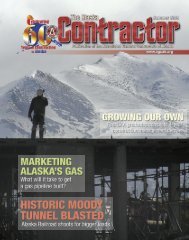The Alaska Contractor - Spring 2011 - Keep Trees
The Alaska Contractor - Spring 2011 - Keep Trees
The Alaska Contractor - Spring 2011 - Keep Trees
You also want an ePaper? Increase the reach of your titles
YUMPU automatically turns print PDFs into web optimized ePapers that Google loves.
FINANCIAL SERVICES & CONTRACTORS<br />
<strong>Contractor</strong> fi nancing from a<br />
banker’s perspective<br />
Obtaining optimal fi nancing during diffi cult or uncertain<br />
times rests on the quality and accuracy of current<br />
fi nancial statements.<br />
<strong>Contractor</strong>s, more than other industries in general, are<br />
fi nding the going rough as a result of the great recession and<br />
credit crunch of the past few years.<br />
<strong>Contractor</strong>s are sensitive to business cycles, experience<br />
wider revenue swings and deal with high levels of competition.<br />
<strong>The</strong>se factors make contractor fi nancing more challenging for<br />
banks and therefore it becomes imperative for contractors to<br />
clearly demonstrate their creditworthiness.<br />
How do banks determine your creditworthiness?<br />
Bankers lend to contractors who clearly communicate and<br />
demonstrate their ability to repay their loans.<br />
<strong>The</strong> fi nancial statements most critical in the determination<br />
of creditworthiness are: balance sheet, income statement,<br />
accounts receivable and inventory aging, job status reports<br />
and cash fl ow projections<br />
Are the fi nancial statements prepared in-house or by a CPA?<br />
Are the statements of compiled, reviewed or audited quality?<br />
Third-party confi rmation provides more assurance to bankers.<br />
Primarily a banker must determine if cash fl ow generated<br />
from the operations of the business will be suffi cient to repay<br />
the loan and still meet all other existing and proposed obligations<br />
for that business.<br />
Bankers need to see contracts and cash fl ow projections.<br />
Much of the contractor’s working capital is tied up in construction-in-progress<br />
inventory. Progress billings acceptable to the<br />
project owners are the contractor’s source of cash for labor,<br />
materials, taxes, debt service and other associated costs. A<br />
banker will need monthly and quarterly cash fl ow projections<br />
over the life of these contracts.<br />
In addition to the cash fl ow banks review both collateral<br />
and personal guarantees from the owners. Repossessing equipment<br />
often puts a contractor out of business while collecting<br />
on billings for work-in-progress is sometimes futile. <strong>The</strong> work<br />
is usually not fi nished so it becomes diffi cult to collect.<br />
If a contract is bonded and not completed by the contractor<br />
the bonding company normally takes fi rst position over the<br />
bank’s rights. Many contractor loans are viewed as unsecured<br />
even with collateral. Personal guarantees and fi nancial capacity<br />
are what banks look for.<br />
Banks consider both fi nancial and non-fi nancial factors<br />
but the following four fi nancial factors are: primary profi tability,<br />
solvency, liquidity and fi nancial leverage.<br />
Many jobs or contracts carry high costs up front and the<br />
BI L L CESSNUN<br />
Vice President,<br />
Northrim Bank<br />
profi ts are realized later on. A contractor must demonstrate the<br />
ability to fi nish jobs profi tably.<br />
Does the company have the cash and working capital on<br />
hand to cover a few months of payroll and other payables?<br />
Will the contractor be able to meet both short- and longterm<br />
obligations to debt and equity holders? <strong>The</strong> more positive<br />
tangible net worth there is, the better the solvency picture will be.<br />
Is there enough cash fl ow to cover principal and interest, capital<br />
expenditures, rent and lease payments, and other equity draws?<br />
If contractors are highly leveraged with debt there can be a<br />
problem. Debt to worth ratios paint a picture, however the terms<br />
of debt are important. If debt to worth is 4:1 and the majority of<br />
debt is longer term then banks are somewhat assured there is<br />
not a large short-term debt due.<br />
Additionally, banks will consider many non-fi nancial factors:<br />
• Is the contractor a general or subcontractor? Generals<br />
are one step closer to the contract owner, or the source of<br />
payment.<br />
• What is management’s experience? How capable<br />
is management? Is there excessive turnover in<br />
management?<br />
• Is the owner involved? Close supervision by vested<br />
owners positively impacts time and on-budget success.<br />
• What are the billing practices? Bankers will be wary of<br />
front end loaded billings.<br />
• Who are the customers involved? Some public jobs have<br />
lower margins but are larger contracts.<br />
• How seasonal and cyclical is the contractor’s business?<br />
• How capital intensive is the business?<br />
• What is the condition of the equipment?<br />
• What are the OSHA and workmen’s compensation records?<br />
This impacts insurance premiums.<br />
What is the competitive landscape?<br />
In the end a banker will weigh the strengths and weaknesses<br />
of both fi nancial and non-fi nancial factors. High-quality leadership<br />
for the contractor’s business will be the most critical component,<br />
yet the fi nancial picture must make sense and provide<br />
cushion for the “unknown” or possible future negatives.<br />
Expect banks to require loan covenants to include ongoing<br />
fi nancial reporting, minimum fi nancial ratios like current ratio,<br />
debt to worth ratio, and a minimum tangible net worth. Each<br />
contractor is unique so these loan covenants will vary.<br />
Building a strong relationship with your bank is an outcome<br />
of clear communication and full exchange of information. <strong>The</strong><br />
better the information the better the decisions made.<br />
44 <strong>The</strong> <strong>Alaska</strong> conTrAcTor <strong>Spring</strong> <strong>2011</strong>

















